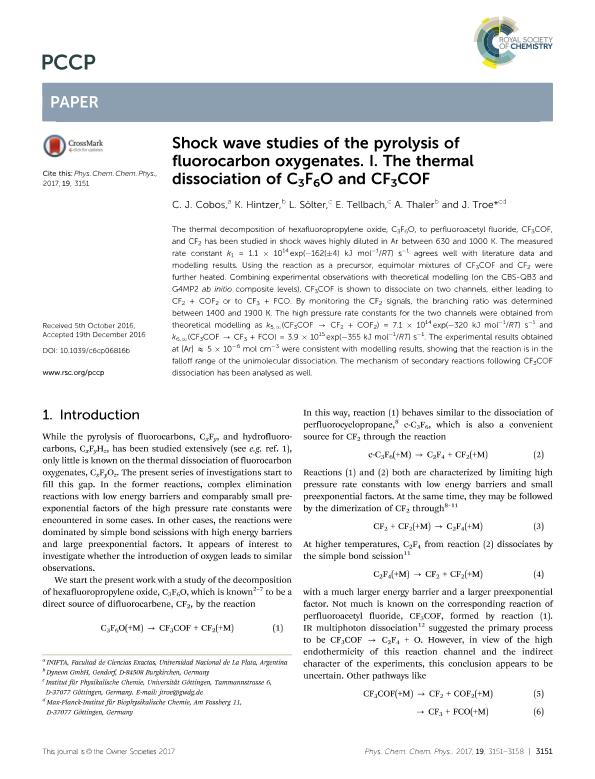Mostrar el registro sencillo del ítem
dc.contributor.author
Cobos, Carlos Jorge

dc.contributor.author
Hintzer, K.
dc.contributor.author
Sölter, L.
dc.contributor.author
Tellbach, E.
dc.contributor.author
Thaler, A.
dc.contributor.author
Troe, J.
dc.date.available
2018-11-08T18:23:59Z
dc.date.issued
2017-03
dc.identifier.citation
Cobos, Carlos Jorge; Hintzer, K.; Sölter, L.; Tellbach, E.; Thaler, A.; et al.; Shock wave studies of the pyrolysis of fluorocarbon oxygenates. I. The thermal dissociation of C3F6O and CF3COF; Royal Society of Chemistry; Physical Chemistry Chemical Physics; 19; 4; 3-2017; 3151-3158
dc.identifier.issn
1463-9076
dc.identifier.uri
http://hdl.handle.net/11336/64002
dc.description.abstract
The thermal decomposition of hexafluoropropylene oxide, C3F6O, to perfluoroacetyl fluoride, CF3COF, and CF2 has been studied in shock waves highly diluted in Ar between 630 and 1000 K. The measured rate constant k1 = 1.1 × 1014exp(-162(±4) kJ mol-1/RT) s-1 agrees well with literature data and modelling results. Using the reaction as a precursor, equimolar mixtures of CF3COF and CF2 were further heated. Combining experimental observations with theoretical modelling (on the CBS-QB3 and G4MP2 ab initio composite levels), CF3COF is shown to dissociate on two channels, either leading to CF2 + COF2 or to CF3 + FCO. By monitoring the CF2 signals, the branching ratio was determined between 1400 and 1900 K. The high pressure rate constants for the two channels were obtained from theoretical modelling as k5,∞(CF3COF → CF2 + COF2) = 7.1 × 1014exp(-320 kJ mol-1/RT) s-1 and k6,∞(CF3COF → CF3 + FCO) = 3.9 × 1015exp(-355 kJ mol-1/RT) s-1. The experimental results obtained at [Ar] ≈ 5 × 10-6 mol cm-3 were consistent with modelling results, showing that the reaction is in the falloff range of the unimolecular dissociation. The mechanism of secondary reactions following CF3COF dissociation has been analysed as well.
dc.format
application/pdf
dc.language.iso
eng
dc.publisher
Royal Society of Chemistry

dc.rights
info:eu-repo/semantics/openAccess
dc.rights.uri
https://creativecommons.org/licenses/by-nc-sa/2.5/ar/
dc.subject.classification
Otras Ciencias Químicas

dc.subject.classification
Ciencias Químicas

dc.subject.classification
CIENCIAS NATURALES Y EXACTAS

dc.title
Shock wave studies of the pyrolysis of fluorocarbon oxygenates. I. The thermal dissociation of C3F6O and CF3COF
dc.type
info:eu-repo/semantics/article
dc.type
info:ar-repo/semantics/artículo
dc.type
info:eu-repo/semantics/publishedVersion
dc.date.updated
2018-10-22T22:30:31Z
dc.journal.volume
19
dc.journal.number
4
dc.journal.pagination
3151-3158
dc.journal.pais
Reino Unido

dc.description.fil
Fil: Cobos, Carlos Jorge. Consejo Nacional de Investigaciones Científicas y Técnicas. Centro Científico Tecnológico Conicet - La Plata. Instituto de Investigaciones Fisicoquímicas Teóricas y Aplicadas. Universidad Nacional de La Plata. Facultad de Ciencias Exactas. Instituto de Investigaciones Fisicoquímicas Teóricas y Aplicadas; Argentina
dc.description.fil
Fil: Hintzer, K.. Dyneon GmbH; Alemania
dc.description.fil
Fil: Sölter, L.. Universität Göttingen; Alemania
dc.description.fil
Fil: Tellbach, E.. Universität Göttingen; Alemania
dc.description.fil
Fil: Thaler, A.. Dyneon GmbH; Alemania
dc.description.fil
Fil: Troe, J.. Universität Göttingen; Alemania. Max-Planck-Institut für Biophysikalische Chemie; Alemania
dc.journal.title
Physical Chemistry Chemical Physics

dc.relation.alternativeid
info:eu-repo/semantics/altIdentifier/doi/http://dx.doi.org/10.1039/C6CP06816B
dc.relation.alternativeid
info:eu-repo/semantics/altIdentifier/url/https://pubs.rsc.org/en/Content/ArticleLanding/2017/CP/C6CP06816B
Archivos asociados
